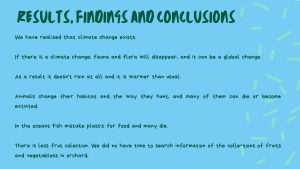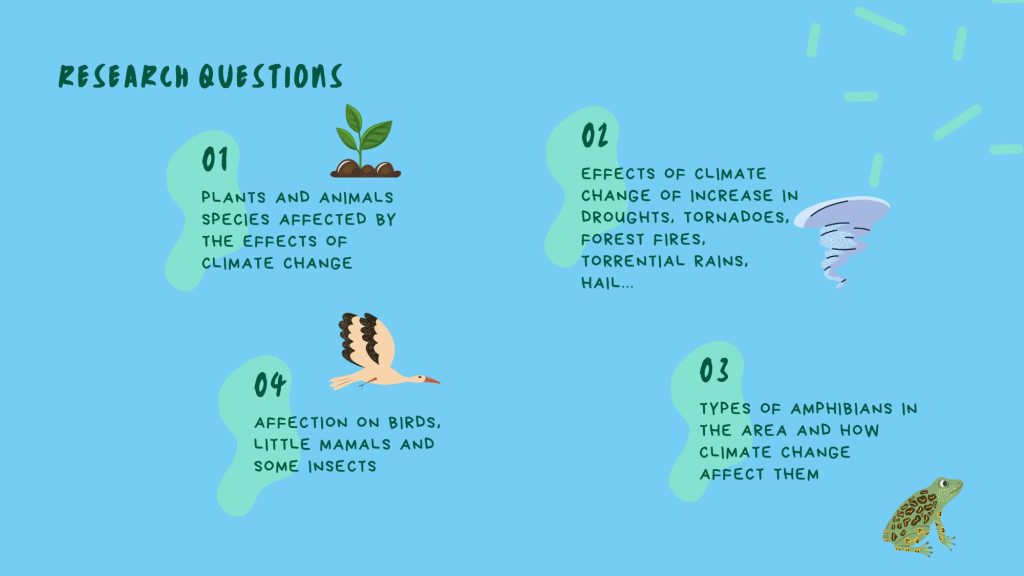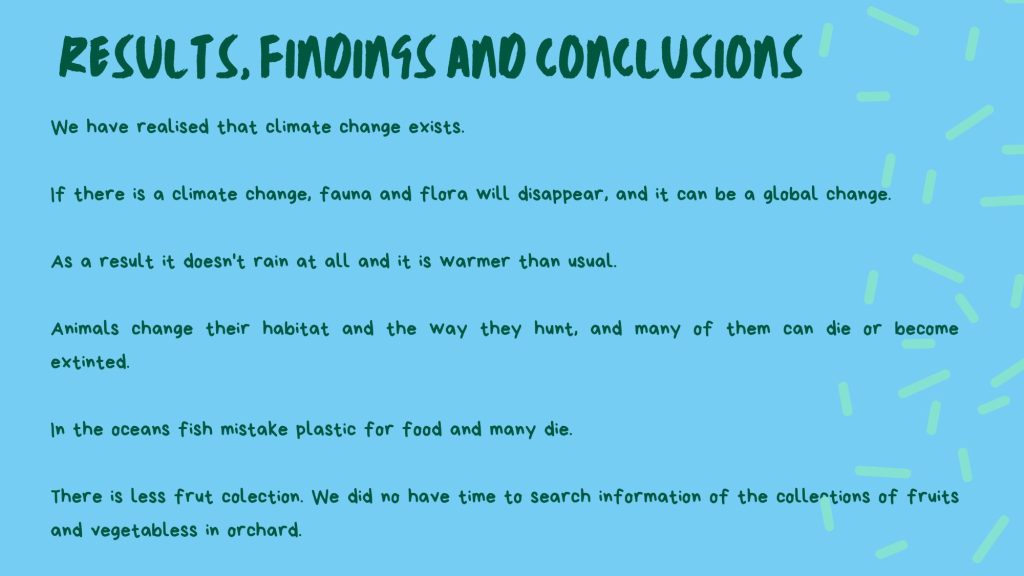Climate Detectives Projects 2022-2023
Project title: Group 2 – Question 2 Biodiversity and climate change in Lower Aragon
Team: CEIP Juan Sobrarias 2
CEIP Juan Sobrarias Alcañiz Spain 23 Student’s age: 10-11 years old
How does climate change affect biodiversity in our area?
¿Cómo afecta el cambio climático en la biodiversidad de nuestra zona?

The 5th and 6th year primary school students wanted to study whether climate change really exists, as they had heard contradictory versions on the same subject. Once they had done their research, they wanted to diagnose the plant and animal species in the municipality that are being seriously affected by the effects of climate change.
Given that the mountain is Mediterranean, they have been investigating the effects of climate change on the
increase in forest fires, drought, torrential rains, hail, tornadoes,…
In addition, they wanted to discuss the effect of climate change on amphibians in the municipality. To this end, they wanted to determine the species present and their possible effects.
One issue of concern was the effect on birds and small mammals: why weren’t the storks leaving? Why was there less fruit and vegetable picking this summer? Why are the bees disappearing?
Not all the questions raised could be answered, but most of them could be answered.
El alumnado internivelar de 5º y 6º de Primaria ha querido estudiar si realmente existe el cambio climático, ya que habían oído versiones contradictorias sobre el mismo tema. Una vez que han investigado sobre ello, han querido diagnosticar en el municipio las especies vegetales y animales que están siendo afectadas de manera grave por los efectos del cambio climático.
Dado que el monte es mediterraneo han estado investigando los efectos del cambio climático en el
incremento de los incendios forestales, sequía, lluvias torrenciales, granizo, tornados,…
Además, quería tratar sobre la afección sobre los anfibios del cambio climático en el municipio. Para ello querían determinar las especies presentes y su posible afección.
Un tema que les preocupaba era la afección sobre las aves y sobre mamíferos pequeños. ¿Por qué no se iban las cigüeñas? ¿Por qué este verano ha habido menos recogida de frutas y hortalizas? ¿Por qué están desapareciendo las abejas?
No se ha podido dar respuesta a todas las preguntas planteadas pero sí a la mayoría.

The students have shown that the glaciers in the Pyrenees are thawing, affecting the fauna and flora of the area.
There are changes in wildlife, such as changes in the animals’ diet, changes in hunting times or changes in habitat.
Climate and weather changes such as drought and fires affect our forests.
A fungus, which survives in temperate waters, affects some 500 species of amphibians in 60 countries.
There are 53 invasive animal species, 9 of them in Aragon, which affect native fauna, such as the snow vole.
Scabies disease has been affecting the Spanish goat since 2014.
Storks live close to landfills and do not fly their migratory routes.
The temperature of the planet will increase by 5°C in the next 80 years and 95% of this is due to humans.
In conclusion, the students have seen that climate change really exists, they have shown concern but they have also become aware that everyone has to contribute their support to mitigate climate change. With the project they have managed to answer most of the research questions, although it remains to be studied whether climate change affects the gardens. The students would have liked to investigate more through current news and would have liked to answer all the questions, but even so, they have been very satisfied with their research work and have decided that they are not going to stay here, but will continue working on the investigation of native plants for the renaturalisation of our playground, as the school is immersed in a project of Patios for the Climate.
El alumnado ha evidenciado que los glaciares del Pirineo se están deshelando con lo que afecta a la fauna y la flora de la zona.
Hay cambios en la fauna, como la dieta de los animales, el cambio de horario de caza o el cambio de hábitat.
Se dan cambios climáticos y meteorológicos como la sequía o los incendios afectan a nuestros bosques.
Existe un hongo, que sobrevive en aguas templadas, que afecta a unas 500 especies de anfibios de 60 países.
Existen 53 especies invasoras de animales, 9 de ellas en Aragón, que afectan a la fauna autóctona, como el topillo nival.
La enfermedad de la sarna afecta a la cabra hispánica desde el 2014.
Las cigüeñas viven cerca de los vertederos y no realizan sus rutas migratorias.
La temperatura del planeta aumentará en 5ºC en los próximos 80 años y un 95% de esto es debido al ser humano.
Como conclusión el alumnado ha comprobado que realmente existe un cambio climático, han mostrado preocupación pero también han tomado conciencia de que todos han de aportar su apoyo para mitigar dicho cambio. Con el proyecto han conseguido responder a la mayoría de las preguntas de la investigación, aunque quedaría por estudiar si el cambio climático afecta a los huertos. Al alumnado le hubiera gustado investigar más a través de noticias de actualidad y le hubiera gustado dar respuesta a todas las preguntas, pero aun así, han estado muy satisfechos con su trabajo de investigación y han decidido que no van a quedarse aquí, sino que van a seguir trabajando en la investigación de plantas autóctonas para la renaturalización de nuestro recreo, ya que el centro está inmerso en un proyecto de Patios por el Clima.

Once the pupils have become aware that climate change really exists, they have realised everything that our school is working on: raising pupils’ awareness, a programme of recycling assistants, naturalising the playground, renovating it to create more green areas, a small pond with native amphibians, covering the playground to provide shade and avoid excessive heat in summer.
In addition to all this, the 4th, 5th and 6th grade students are working on an interdisciplinary project to study the native plants of our area in order to plant the most suitable ones in the playground and preserve the flora of our area.
As individuals, they feel they should try to curb climate change and are very conscious of recycling, as well as using public transport, not using or avoiding plastics and aluminium foil in their lunches and avoiding consumption if not needed.
Una vez que el alumnado ha tomado conciencia de que realmente existe el cambio climático, se ha dado cuenta de todo en lo que nuestro centro escolar se está trabajando: en la concienciación del alumnado, en un programa de ayudantes del reciclaje, en la naturalización del natio, renovándolo para poner más zonas verdes, una pequeña charca con anfibios autóctonos, cubierta del patio para proyectar zonas de sombra y evitar el exceso de calor en verano.
Además de todo esto, el alumnado de 4º, 5º y 6º de primaria está trabajando en un proyecto interdisciplinar para estudiar las plantas autóctonas de nuestra zona y poder plantar las más adecuadas en el patio y poder preservar la flora de nuestra zona.
Como individuos, piensan que deben intentar frenar el cambio climático y están muy concienciados con el reciclaje, así como con el uso de transporte público, con no utilizar o evitar los plásticos y el papel de aluminio en sus almuerzos y con evitar el consumo si no se necesita.
Grupo-de-Olga_Detectives-climaticos_compressed.pdf
This project was automatically translated into English.
Projects are created by the teams and they take the full responsibility of the shared data.
← All projects





